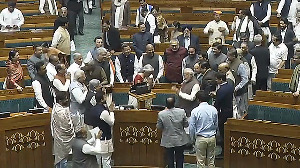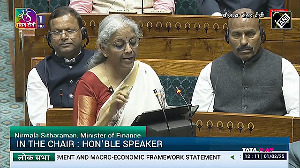Public sector banks are up in arms against a proposal to free the savings bank interest rate -- the last bastion of administered rates.
The Reserve Bank of India has been toying with the idea of freeing interest rates on savings account deposits for quite some time now but it has not gone ahead with the proposal.
The central bank feels the move will lead to a rise in interest cost for public sector banks and squeeze their net interest rate margin.
Pressure from private and foreign banks to free the savings bank rate has increased and the finance ministry is also believed to be in favour of the proposal.
The savings bank deposit rate is now 3.5 per cent. In April 2003, the central bank cut the rate by half a percentage point from 4 per cent. There has been some talk among bankers of freeing the rate but keeping a floor for it.
In other words, if the proposal gets the RBI's nod, banks will be allowed to offer any rate they want on savings deposit accounts but the rate will have to be above 3.5 per cent.
Some bankers fear that this will trigger a fierce rate war and the public sector banks will be at the losing end. In percentage terms, the share of savings deposits in total bank deposits varies among banks.
For instance, for Punjab National Bank it is over 30 per cent while Corporation Bank's savings deposit kitty could be as low as 15 per cent of its total deposits.
The average share of savings bank deposits in the total deposits in public sector banks could be around 25-30 per cent. For foreign and private sector banks, it is lower.
According to the RBI's "Handbook of Statistics on the Indian Economy," in 2003-04 the total savings deposits of Indian banks were Rs 3,73,137 crore (Rs 3731.37 billion). Foreign banks had a savings deposit kitty of Rs 12,232 crore (Rs 122.32 billion), taking the total savings deposits to Rs 385,369 crore (Rs 3853.69 billion).
A senior banker said the minimum balance kept in the savings account of a pubic sector bank is much lower than that of a private or a foreign bank.
"This will come down further once private and foreign banks hike their savings bank rate. So, we will see a flight of deposits of high net worth individuals from the public sector bank fold," the banker said.
Even though the savings bank deposit rate is 3.5 per cent, the actual cost for a bank is about 2.8 per cent as banks pay the interest rate on the basis of the lowest amount kept in the deposit between the 10th and the last day of a month.
Even then, since the minimum balance for a public sector bank's savings deposit is very low, banks do not make any money on savings bank deposits as the transactions cost are very high.






 © 2025
© 2025